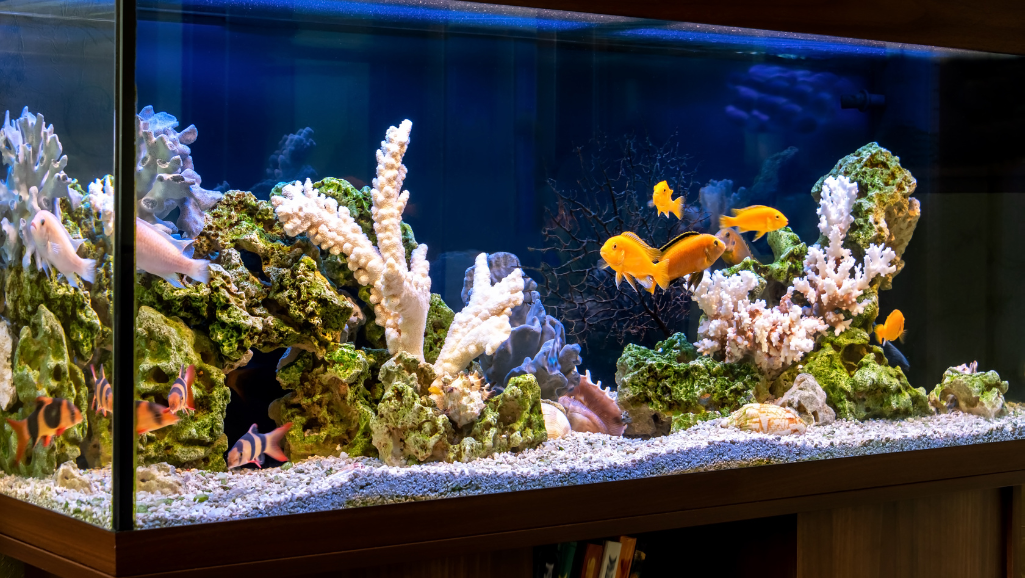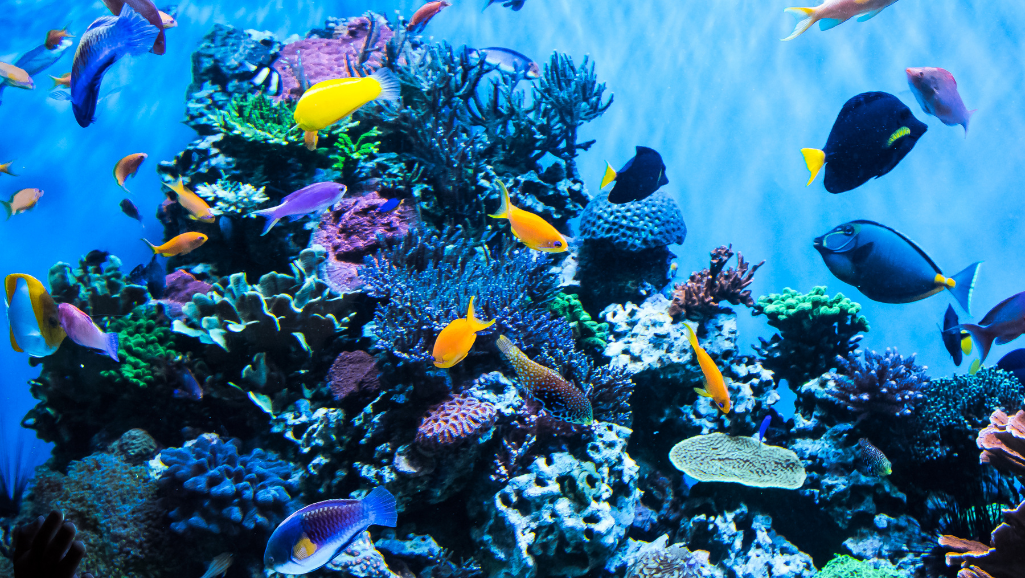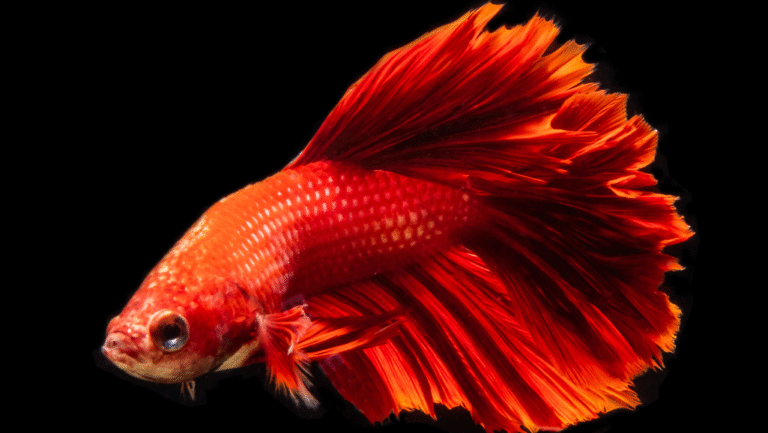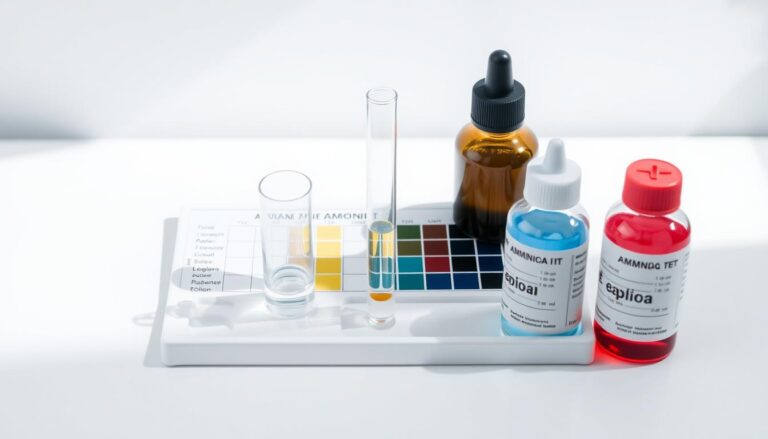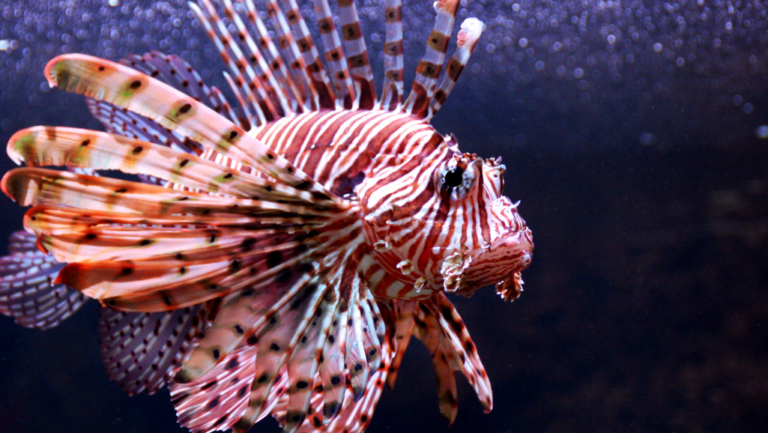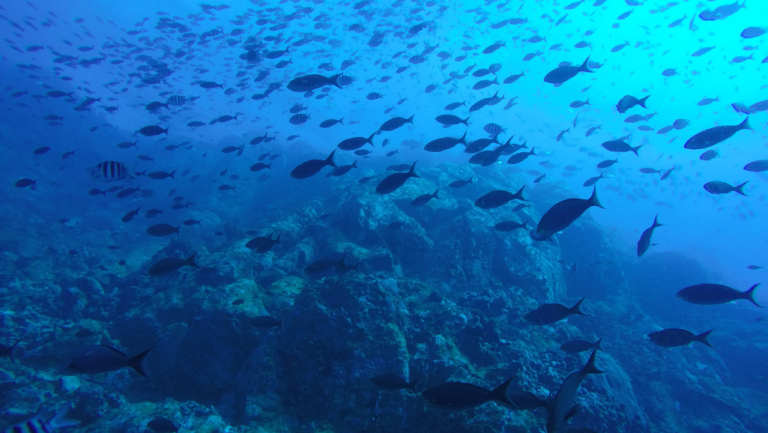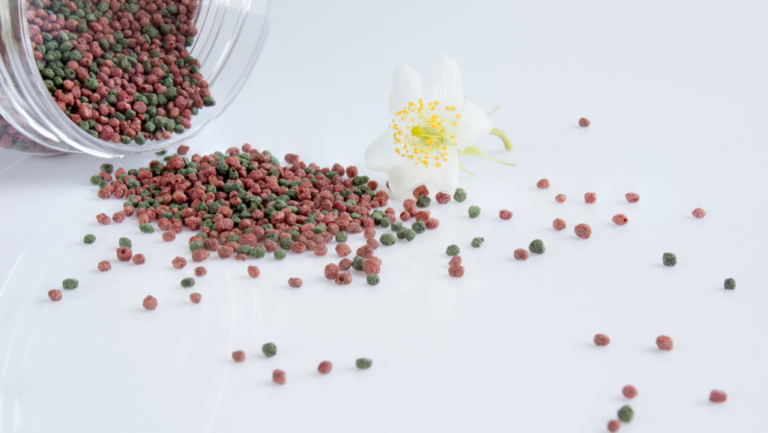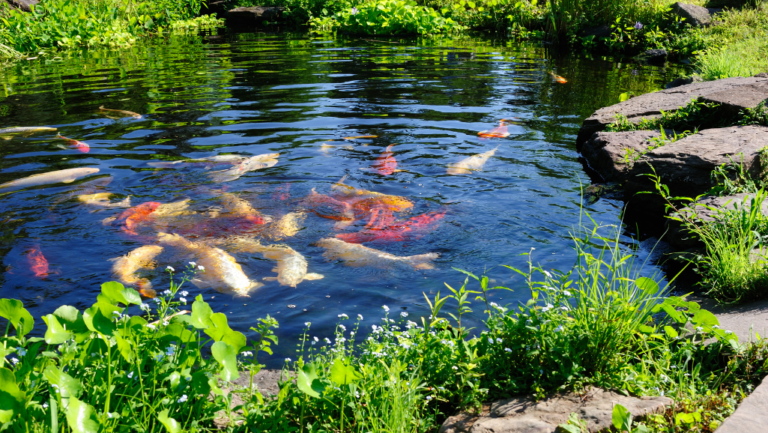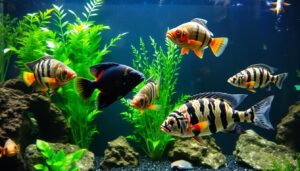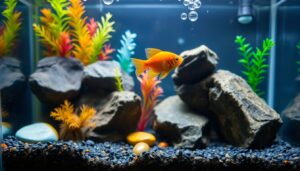Keeping your aquarium water quality at its best is vital for your fish’s health. Managing ammonia levels is a big challenge in fish tank care. Ammonia toxicity can be deadly to your fish, so it’s crucial to know how to keep it low.
Ammonia comes from fish waste, decaying plants, and leftover food. In the wild, it’s diluted by huge amounts of water. But in a small aquarium, it can build up fast. It’s important to manage the ammonia cycle well to keep your tank healthy.
Key Takeaways:
- How to Keep Ammonia Levels Down.
- Ammonia levels in fish tanks should always be as close to zero as possible.
- Beneficial bacteria play a crucial role in converting ammonia into less harmful compounds through the nitrogen cycle.
- Regular water changes, proper filtration, and avoiding overfeeding can help control ammonia levels.
- Live plants can assist in naturally filtering out ammonia and other waste products.
- Monitoring ammonia levels with test kits is essential for maintaining a healthy aquarium.
Understanding Ammonia in Aquariums
Ammonia is very harmful to fish, even in small amounts. It can cause stress and harm. To keep fish healthy, aquariums should have almost no ammonia. Fish health is best when ammonia levels are zero.
To check ammonia levels, use water testing kits. These tools help keep the water quality right for fish. The goal is to have no ammonia in the tank, showing 0 ppm (parts per million).
Sources of Ammonia in Fish Tanks
The main sources of ammonia are fish waste, uneaten food, and decaying plants. These break down and release ammonia. Other things that can raise ammonia levels include:
- Too many fish in the tank
- Feeding too much or not cleaning up leftovers
- Bad filtration or not keeping the tank clean
- New tanks that haven’t cycled properly
Effects of High Ammonia Levels on Fish
High ammonia can make fish act strangely. They might:
- Swim erratically or seem stressed
- Have trouble breathing and move their gills fast
- Look pale or dark
- Stop eating and seem tired
Ammonia poisoning weakens fish and makes them sick. If ammonia levels are too high, it can be deadly.
Testing the water often and keeping it clean is key. It helps prevent ammonia buildup and keeps fish healthy.
Establishing a Mature Biological Filter
A healthy aquarium needs a mature biological filter. This filter is home to beneficial bacteria. They are key in the nitrogen cycle, turning toxic ammonia into safer compounds. Knowing the importance of biological filtration and following the right steps helps keep your fish healthy.
The Nitrogen Cycle in Aquariums
The nitrogen cycle is essential in aquariums. It changes ammonia, a harmful waste from fish and decaying matter, into safer substances. The cycle starts with ammonia conversion by nitrifying bacteria, turning ammonia into nitrite and then nitrate.
Research shows nitrifying bacteria thrive in a pH range of 6.8 to 7.2. They also need an alkalinity of about 150 mg/L to grow. It’s important to check water quality regularly during the biofilter setup.
Importance of Beneficial Bacteria
Beneficial bacteria are crucial for a healthy aquarium. They live on surfaces like the substrate, decorations, and biological filter media. These bacteria form biofilms, helping to process waste and keep the water clear.
Autotrophic and heterotrophic bacteria both play key roles in water quality. Autotrophic bacteria consume chemicals like ammonia. Heterotrophic bacteria break down organic compounds, preventing cloudy water. Studies suggest heterotrophic bacteria need more surface area than autotrophic ones.
“Beneficial bacteria on the surface of the biomedia in the filter break down toxic ammonia into nitrate, converting it into a non-toxic form of nitrogen.” – Aquarium Expert
Fishless Cycling Method
The fishless cycling method is a great way to set up a biological filter. It involves setting up the tank without fish, allowing bacteria to grow before adding fish. Adding ammonia and monitoring its levels helps ensure the filter is ready.
Fishless cycling usually takes 4 to 8 weeks. Factors like temperature, pH, and bacteria availability affect this time. Keeping ammonia levels between 3 to 5 mg/L is crucial during this period.
Maintaining Proper Fish Stocking Levels
High ammonia levels in aquariums often come from too many fish. When there are too many fish, the waste can overwhelm the filter. This leads to toxic ammonia buildup. It’s key to keep the right number of fish for your tank’s size and the fish species.
One inch of fish per gallon of water is a common rule. But, some fish like goldfish and cichlids need more space. You must research each fish’s needs and make sure your tank is big enough.
Think about your fish’s behavior and how well they get along. Some fish get aggressive when crowded, while others need to be in schools. Choosing the right fish and giving them enough space helps keep stress low and ammonia levels stable.
If your tank is too full, you need to act fast. You might need to move some fish, get a bigger tank, or change the water more often. Keeping your fish population in check helps keep your aquarium healthy and balanced.
Avoiding Overfeeding and Removing Uneaten Food
Overfeeding is the main cause of many aquarium problems. It can lead to deadly changes in water chemistry and stressed fish. Too much food means too much organic matter, which turns into harmful ammonia and nitrites.
Food and fish waste release proteins that turn into these dangerous compounds. The breakdown of organic material also lowers dissolved oxygen and raises carbon dioxide levels. This can lower the pH, affecting fish that need specific pH levels.
Feeding Guidelines for Optimal Water Quality
To keep water quality good and avoid overfeeding, follow these tips:
- Feed small amounts twice daily
- Provide only what fish can eat in 2 minutes
- Choose the right food for your fish
- Teach family members about proper feeding times
It’s also key to have a filtration system that fits your tank size. Malnutrition from not feeding enough is rare, but overfeeding problems are common.
Removing Excess Food and Waste
Quickly take out any uneaten food to stop it from harming water quality. Regularly vacuum the substrate to get rid of fish waste and debris. Protein skimming can also help remove dissolved organic compounds before they turn into ammonia.
By controlling food amounts, doing regular maintenance, and removing waste, you can avoid issues like fin rot, fatty liver disease, algae blooms, cloudy water, and clogged filters. These problems often come from overfeeding.
Maintaining proper feeding practices is key for your aquarium fish’s health and happiness. With careful attention and consistency, you can stop overfeeding and keep your tank’s water quality perfect.
Incorporating Live Plants for Ammonia Control
Live aquatic plants are great for any aquarium. They look good and help control ammonia naturally. Planted tanks are balanced and sustainable, using compounds from fish waste and leftover food.
Plants absorb ammonia as part of their nutrition. This helps the nitrogen cycle in the tank. But, plants can’t remove all ammonia, so other methods are needed too.
Benefits of Live Plants in Aquariums
Adding live plants to your aquarium has many advantages. They:
- Naturally filter and absorb ammonia
- Improve water quality and clarity
- Boost oxygen levels through photosynthesis
- Compete with algae for nutrients
- Make the tank look better and feel more natural for fish
Best Plants for Ammonia Removal
Some plants are better at removing ammonia than others. Fast-growing plants like hornwort and water sprite are great. They quickly take in ammonia, nitrites, and nitrates.
Other good plants for tanks include:
- Amazon sword
- Java moss
- Anubias
- Cryptocoryne
- Vallisneria
To help plants grow well and remove ammonia, give them the right light, CO2, and fertilizers. A healthy planted tank means less ammonia and a better home for your fish.
How to Keep Ammonia Levels Down: Regular Maintenance
Keeping your aquarium healthy needs regular effort. Simple practices can help manage ammonia levels. This way, you can ensure a safe space for your fish.
Importance of Routine Water Changes
Regular water changes are key to controlling ammonia. Try to change 25-50% of the tank water each week. This helps lower ammonia and keeps your fish healthy.
When changing water, use dechlorinated water. This avoids adding harmful chemicals to your tank.
Using Ammonia Detoxifiers and Removal Products
Ammonia detoxifiers and removal products can help in emergencies. They neutralize ammonia, making it safer for fish. But, it’s important to fix the ammonia problem for good.
“The recommended water change to reduce ammonia levels is 20% of the tank volume, which should be done over 2-3 days.”
Monitoring Ammonia Levels with Test Kits
Testing ammonia levels regularly is vital. Use reliable test kits to catch problems early. These kits are affordable, costing $5-$10.
By testing often, you can spot and fix ammonia spikes quickly. This protects your fish.
Consistency is the secret to a healthy aquarium. Regularly practicing these steps helps manage ammonia. This way, you create a great home for your fish.
Conclusion
Keeping ammonia levels low is key for your fish’s health. Knowing where ammonia comes from, like overfeeding, helps you act fast. A good biological filter and beneficial bacteria are essential for breaking down ammonia.
Keeping fish numbers in check and not overfeeding are simple steps. Live plants also help by absorbing ammonia. Regular water changes and using test kits to check ammonia levels are crucial for clean water.
Getting your aquarium to control ammonia takes time and effort. By following the tips in this guide, you can make a great home for your fish. A balanced, ammonia-free tank is the start of a rewarding fishkeeping journey.

